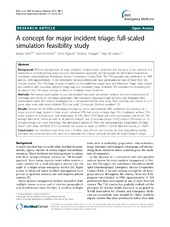| dc.description.abstract | Background Efficient management of major incidents involves triage, treatment and transport. In the absence of a standardised interdisciplinary major incident management approach, the Norwegian Air Ambulance Foundation developed Interdisciplinary Emergency Service Cooperation Course (TAS). The TAS-program was established in 1998 and by 2009, approximately 15 500 emergency service professionals have participated in one of more than 500 no-cost courses. The TAS-triage concept is based on the established triage Sieve and Paediatric Triage Tape models but modified with slap-wrap reflective triage tags and paediatric triage stretchers. We evaluated the feasibility and accuracy of the TAS-triage concept in full-scale simulated major incidents. Methods The learners participated in two standardised bus crash simulations: without and with competence of TAS-triage and access to TAS-triage equipment. The instructors calculated triage accuracy and measured time consumption while the learners participated in a self-reported before-after study. Each question was scored on a 7-point Likert scale with points labelled "Did not work" (1) through "Worked excellent" (7). Results Among the 93 (85%) participating emergency service professionals, 48% confirmed the existence of a major incident triage system in their service, whereas 27% had access to triage tags. The simulations without TAS-triage resulted in a mean over- and undertriage of 12%. When TAS-Triage was used, no mistriage was found. The average time from "scene secured to all patients triaged" was 22 minutes (range 15-32) without TAS-triage vs. 10 minutes (range 5-21) with TAS-triage. The participants replied to "How did interdisciplinary cooperation of triage work?" with mean 4,9 (95% CI 4,7-5,2) before the course vs. mean 5,8 (95% CI 5,6-6,0) after the course, p < 0,001. Conclusions Our modified triage Sieve tool is feasible, time-efficient and accurate in allocating priority during simulated bus accidents and may serve as a candidate for a future national standard for major incident triage. | en_US |

